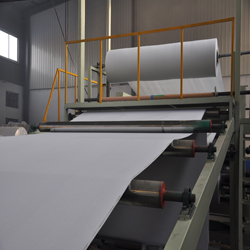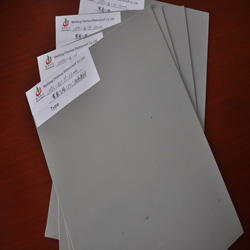PVC waterproof membrane with fabric
- Loading Port:
- Qingdao
- Payment Terms:
- TT OR LC
- Min Order Qty:
- -
- Supply Capability:
- 100000 m²/month
OKorder Service Pledge
OKorder Financial Service
You Might Also Like
PVC (polyvinyl chloride) roof membrane
is an excellent high quality polymer waterproof sheet, made of PVC resin by adding plasticizer,
anti-UV agent, anti aging agent, and stabilizer and other processing aids through extrusion
and molding.As the highly recommended product by the Ministry of Construction, it is featured by high tensile
strength, great elongation, good stability, small shrinkage, low temperature performances, good resistance to
weathering and root penetration, and long service life.

Physical Property:
1.Good combination of high elasticity and tensile strength.
2.Fine resistance to static electricity.
3.Excellent resistance to ageing / weathering.
4.Durable,the effective age can be more than 20 years used on exposed surfaces,used on non-exposed surfaces,it can reach 50 years.
5.Fine flexibility at low temperature,adaptable to cold conditions.
6.Root-resistance,can be used on the planting roofs.
7.Fine puncture resistance, joint peel strength and joint shear strength.
8.Fine UV-resistance,no pollution to environment.
9.Easily welding,installing,secure.
10.Easy treatments to the delicate parts of corners and edges.
11.Convenient maintenance with low cost.
Polyvinyl Chloride (PVC) membrane with fiber reinforced layer
on the back is widely used in the roofs of civil buildings,
tunnels, channels, subways, highways, planting roofs, the roofs of steel
frame structure buildings, and etc.

- Q:How does a waterproofing membrane withstand freeze-thaw cycles?
- A waterproofing membrane withstands freeze-thaw cycles by being designed with materials that can expand and contract without losing their integrity. These membranes are typically made of rubber or synthetic polymers that are flexible enough to accommodate the expansion and contraction caused by freezing and thawing temperatures. Additionally, they are formulated to resist water penetration even when subjected to these cyclical temperature changes, ensuring their effectiveness in preventing water damage.
- Q:The difference between high polymer modified asphalt waterproofing membrane and sbs
- High-polymer modified asphalt waterproofing membrane: synthetic polymer modified asphalt coating layer, fiber fabric or fiber mat for the carcass, powder, granular, sheet or film material made of cladding material can be curled Of the sheet material. Thickness is generally 3mm, 4mm, 5mm, asphalt as the main body.
- Q:Can a waterproofing membrane be used for historic preservation projects?
- Yes, a waterproofing membrane can be used for historic preservation projects. Waterproofing membranes are commonly used in construction to protect buildings from water damage, and they can be particularly beneficial in preserving historic structures. By preventing water infiltration, the membrane helps to safeguard the integrity of the building, protect against moisture-related deterioration, and extend the lifespan of the historic structure. However, it is important to ensure that the membrane chosen is compatible with the materials and construction techniques used in the historic building to avoid any adverse effects on its authenticity or structural stability.
- Q:Are waterproofing membranes suitable for historical buildings?
- Under certain circumstances, historical buildings can benefit from the use of waterproofing membranes. These membranes are specifically designed to safeguard structures against water damage, which is especially important for historical buildings that may have aged and porous materials. However, the suitability of waterproofing membranes for historical buildings relies on a variety of factors. First and foremost, it is vital to take into account the unique requirements and characteristics of the historical building in question. Each building possesses distinct materials and features, and the impact of waterproofing on these elements must be thoroughly assessed. Some older structures may possess delicate architectural elements or materials that could be adversely influenced by the application of waterproofing membranes. In such instances, alternative methods that are less intrusive or damaging may be more appropriate. Secondly, it is essential to seek guidance from conservation experts or professionals who specialize in the preservation of historical buildings. These experts can evaluate the specific needs of the building and offer advice on the most suitable waterproofing techniques. They can also ensure that any interventions are executed in a manner that respects the historical integrity and authenticity of the structure. Lastly, it is crucial to consider the long-term consequences of waterproofing membranes on historical buildings. While these membranes can effectively protect against water damage, they may also compromise the natural breathability of the building, potentially leading to moisture accumulation and further deterioration. Therefore, it is imperative to carefully balance the benefits of waterproofing with the potential risks and long-term effects. In conclusion, while waterproofing membranes can be appropriate for historical buildings, caution should be exercised when applying them. A thorough assessment of the building's specific requirements, consultation with preservation experts, and consideration of long-term implications are essential in determining the suitability of waterproofing membranes for historical structures.
- Q:Are there any specific requirements for installing a waterproofing membrane?
- Yes, there are specific requirements for installing a waterproofing membrane. These requirements may vary depending on the type of membrane being used and the specific application. However, some general requirements include: 1. Surface Preparation: The surface where the membrane will be installed must be clean, dry, and free from any dust, debris, or contaminants. Any cracks or defects in the surface should be repaired prior to installation. 2. Adhesive or Bonding Agent: Depending on the type of membrane, an adhesive or bonding agent may be required to ensure proper adhesion to the substrate. This adhesive should be compatible with both the membrane and the substrate. 3. Primer: In some cases, a primer may be necessary to enhance the adhesion between the substrate and the membrane. The type of primer required will depend on the specific membrane and substrate being used. 4. Seam and Joint Preparation: Properly preparing seams and joints is crucial to ensure a watertight installation. This may involve using a specific sealant or tape to reinforce the seams and prevent water penetration. 5. Installation Techniques: The membrane should be installed according to the manufacturer's instructions and industry best practices. This may include using a specific method such as torching, hot air welding, or cold adhesive application. 6. Overlaps and Transitions: Properly overlapping the membrane sheets and ensuring smooth transitions between different areas is essential for a successful installation. This will help prevent water from seeping through gaps or weak points in the membrane. 7. Quality Control: Regular inspections and quality control measures should be implemented throughout the installation process to ensure that the membrane is being installed correctly and meets the required standards. It is important to consult the manufacturer's guidelines and specifications for the specific waterproofing membrane being used, as different membranes may have unique installation requirements. Additionally, local building codes and regulations should also be considered to ensure compliance and to meet any specific requirements in your area.
- Q:Is a waterproofing membrane compatible with different types of flooring materials?
- Yes, a waterproofing membrane is compatible with different types of flooring materials. It can be used with various flooring options like tiles, hardwood, laminate, vinyl, and more to provide protection against water damage and ensure a long-lasting and durable flooring installation.
- Q:Can a waterproofing membrane be used on precast galvanized surfaces?
- Yes, a waterproofing membrane can be used on precast galvanized surfaces. The membrane will provide an additional layer of protection against water penetration and help to prevent corrosion on the galvanized surface.
- Q:Can a waterproofing membrane be used in conjunction with vapor barriers?
- Yes, a waterproofing membrane can be used in conjunction with vapor barriers. In fact, it is often recommended to use both to ensure comprehensive protection against moisture. Waterproofing membranes are designed to prevent water from penetrating through a surface, such as a roof or foundation, while vapor barriers are designed to prevent the passage of water vapor. By using both, you can effectively prevent both liquid water and water vapor from causing damage to a structure. The waterproofing membrane acts as a physical barrier to prevent water from entering, while the vapor barrier prevents the buildup of moisture within the structure. This combination can be particularly beneficial in areas with high humidity or where there is a risk of water intrusion.
- Q:Can a waterproofing membrane be used for roofing?
- Yes, a waterproofing membrane can be used for roofing. In fact, it is a common choice for many roofing applications. Waterproofing membranes are designed to provide a protective barrier against water infiltration, which is essential for preventing leaks and water damage on roofs. These membranes are typically made of durable materials such as asphalt, synthetic rubber, or thermoplastic, which are resistant to water and can withstand harsh weather conditions. They are installed over the roof surface and provide a seamless, watertight layer that helps to keep the interior of the building dry and protected. Additionally, waterproofing membranes can be used on various types of roofs, including flat roofs, sloped roofs, and even green roofs. Overall, using a waterproofing membrane for roofing is an effective way to ensure long-lasting durability and protection against water damage.
- Q:Can a waterproofing membrane be used in residential construction?
- Yes, a waterproofing membrane can be used in residential construction. Waterproofing membranes are commonly used in various areas of a residential property, such as roofs, basements, bathrooms, and foundations. These membranes are designed to prevent water penetration and protect the structure from moisture-related damages. By installing a waterproofing membrane, homeowners can ensure that their property remains dry and free from water leaks, which can lead to mold growth, structural deterioration, and other costly issues. There are various types of waterproofing membranes available in the market, including sheet membranes, liquid membranes, and self-adhering membranes, each with its own advantages and suitability for specific applications. Consulting with a professional contractor or architect can help determine the most appropriate waterproofing membrane for a particular residential construction project.
1. Manufacturer Overview |
|
|---|---|
| Location | |
| Year Established | |
| Annual Output Value | |
| Main Markets | |
| Company Certifications | |
2. Manufacturer Certificates |
|
|---|---|
| a) Certification Name | |
| Range | |
| Reference | |
| Validity Period | |
3. Manufacturer Capability |
|
|---|---|
| a)Trade Capacity | |
| Nearest Port | |
| Export Percentage | |
| No.of Employees in Trade Department | |
| Language Spoken: | |
| b)Factory Information | |
| Factory Size: | |
| No. of Production Lines | |
| Contract Manufacturing | |
| Product Price Range | |
Send your message to us
PVC waterproof membrane with fabric
- Loading Port:
- Qingdao
- Payment Terms:
- TT OR LC
- Min Order Qty:
- -
- Supply Capability:
- 100000 m²/month
OKorder Service Pledge
OKorder Financial Service
Similar products
New products
Hot products
Related keywords






























